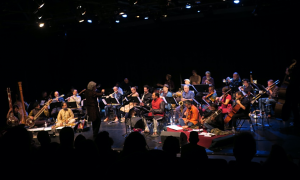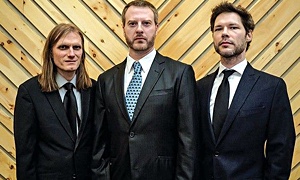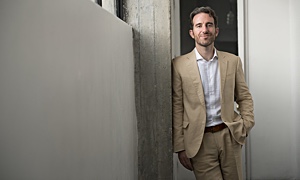Home » Jazz Articles » Live From Philadelphia » March-April 2012: Dan Hanrahan, Matthew Shipp, Danilo Pe...
March-April 2012: Dan Hanrahan, Matthew Shipp, Danilo Perez, Aerial Photograph
Moonstone Arts Center
February 22, 2012
The Moonstone Arts Center, one of Philadelphia's more successful outlets for jazz music, has been growing in popularity amongst local musicians as a venue geared towards supporting original music. Dan Hanrahan, a guitarist well versed in jazz tradition, led his organ trio through a set of arranged standards and original compositions.
The set began with the standard "I'm Getting Sentimental Over You," arranged with an updated bebop-influenced melody and syncopated rhythmic hits. Organist Dave Mattock displayed his technical command of the organ by walking bass lines and taking an extended improvisation on Hanrahan's "Three Colors," a brisk waltz with a modern swing feel. Drummer Kevin Daly, a senior drum student at Temple University, rounded out the group. He and Mattock locked in perfectly, pushing the band forward and providing Hanrahan with a perfect accompaniment. Hanrahan's style recalled the nuances of many of jazz guitar's pioneers such as Grant Green and Tal Farlow. His articulation wassmoother than most traditional players, but his vocabulary displayed an obvious study of bebop and post-bop improvisers.
The Moonstone Arts Center has been hosting jazz shows more frequently this year, and is growing in popularity amongst listeners and fans alike with a calendar featuring Philadelphia's best jazz musicians as well as up-and-coming jazz acts and world music.
Matthew Shipp Trio
University of the Arts
March 13, 2012
The Matthew Shipp Trio, a band largely associated with the avant-garde jazz inspired by musicians such as Ornette Coleman and Cecil Taylor, performed an hour-long single piece set at the University of the Arts.
The most unique aspect of Shipp's Trio was the seamless nature of its entire set. Individual pieces, usually comprised of no more than a few simple themes or melodic motifs, were used as springboards for complete group improvisations. The style of interaction which Shipp's Trio has created is essentially unheard of elsewhere. The musicians do not seem to have borrowed much influence from any previous classic piano trio, even the original Bill Evans trio, which became famous for the interaction between its players on albums including the legendary Sunday at the Village Vanguard (Riverside, 1961). Shipp's Trio has instead gone even further, mostly eliminating any obvious signs of a soloist or clear leader.
Within the Matthew Shipp Trio, there was almost no distinction between soloist and accompanist. In fact, it would seem that the focus of the performance was centered on moving flawlessly from one composition to the next and improvising within each tune's framework. Forms were somewhat disregarded, or treated so liberally that their architecture remained intriguingly beguiling. As a whole, the performance almost felt more like an hour-long tone poem than a largely improvised free jazz set. The Trio did not employ the often harsh instrumental techniques of many other free jazz artists, instead relying on controlled and surprisingly cohesive musical conversation.
Shipp's piano technique included an obvious study of 20th century classical piano repertoire. He often played on the strings of the piano, and employed atonal Gyorgy Ligeti-esque bursts to distinguish one piece from another, rather than stopping for applause. Dynamically, Shipp was reserved compared to many other modern pianists. His rhythmic complexity and classically inspired language created a unique sound, generating enough interest on its own without the need of heavy-handed free playing. This was well matched by the style of drummer Whit Dickey, who also relied more on lighter dynamics and refined conversational interaction, often with brushes or lightly used sticks, providing a steady, brooding energy, but never forcing the music to go any further than it needed to. Bassist Michael Bisio took the only unaccompanied solo of the set, beginning with a long arco introduction which built to an Eastern-inspired modal cadenza.
Shipp released Elastic Aspects (Thirsty Ear, 2012) earlier in the year, and each of the follow-up performances, though always completely unique, have reflected the material on the record.
Danilo Perez Quartet
Kimmel Center
April 14, 2012
Pianist Danilo Pérez led a quartet of jazz stars including drummer Brian Blade, bassist John Patitucci, and saxophonist Kenny Garrett through a set dedicated to Philadelphia native, pianist McCoy Tyner.
The interaction between the musicians was particularly unique compared to most jazz ensemble playing. Often, during the improvisations, the rhythm section seemed to be controlling the direction of each piece more than the individual soloists, who were being fed constantly shifting ideas that quickly became the focal point throughout the set. During several of Garrett's solos, Blade responded to Perez's often syncopated piano accompaniment with his own engaging rhythmic ideas. This interaction then provided Garrett with more material over which to respond and improvise. During some of Perez's solos, Patitucci and Blade accompanied in much the same way. Though jazz musicians are known for seeking a high level of interaction, this quartet accomplished a level of musical empathy in which any musician could provide a new direction at any time.
Pérez's solo rendition of pianist Thelonious Monk's "Ask Me Now" was one of the main highlights of the first set. He mixed elements of Monk's stride-influenced style of comping with harmonic concepts borrowed from 20th century classical music and modern jazz. It is especially unique when an artist interprets the work of a legend while still retaining their own expressive identity. Pérez played some ideas which Monk might have never played, but his interpretation always remained focused and never drifted far from the original melody.
Garret, who has worked with these musicians before but rarely in such a context, is known for having vocabulary based in refined bebop with a touch of free jazz-inspired aggression. His influences seemed to range from Charlie Parker to Jackie McLean, improvising over dissonant modal vamps and modern jazz pieces more than straight-ahead jazz, but never seemed uncomfortable or caught off-guard. Garrett was an obvious choice in terms of musical chemistry, but his ability to adapt to the situation at hand showed a new side to his musicianship.
This performance was preceded by a set from trumpeter Terrell Stafford's Quintet, and concluded the Kimmel Center's Jazz Up Close series.
Matt Davis's Aerial Photograph
Time
April 19, 2012
Aerial Photograph was a band which may have appeared to some to be more a classical chamber ensemble than a group based on original composition and improvisation. While the influence of classical music was certainly present, the band incorporated the freedom of jazz improvisation with several genres of music to create a unique sound, especially within the jazz genre. The group was comprised of a string quartet, wind section, upright bass, drums and guitar. Matt Davis, a New York-based guitarist and composer, has been writing pieces for the group for years. He composes each piece, writing parts for each individual instrument, and then arranges them for the group. Many songs have solo sections which incorporate violins just as often as saxophone or guitar, providing a unique blend of instruments not often heard performing together in any context.
The overall sound of the group, which performs regularly around Philadelphia and New York, possessed elements of Ravel and Debussy in its textural style, but the compositions were often far simpler and seemed inspired by several eclectic forms of music. Pieces like "Benediction," from the band's eponymous 2002 self-produced debut, were very short and based on simple repetitive motifs which layered and then intersected with each other to create a full palette of sound.
Davis' performance style was clearly influenced by modern jazz, but his vocabulary revealed a deeper study of jazz tradition sometimes missing in today's younger players, a unique quality that added a more soulful element. He also displayed a sound grasp of the blues on the closing piece, "City of Age," from Ways and Means (VanDolah Sounds, 2009) a simple song which closed with a slow vamp over which Davis improvised until the piece came to an end on its own.
< Previous
Amanke Dionti
Next >
The Heart of the Geyser
Comments
Tags
Live From Philadelphia
RJ Johnson
United States
Pennsylvania
Philadelphia
Dan Hanrahan
Kevin Daly
Grant Green
Tal Farlow
Matthew Shipp
Ornette Coleman
Cecil Taylor
Bill Evans
Whit Dickey
Michael Bisio
Danilo Perez
Brian Blade
John Patitucci
Kenny Garrett
McCoy Tyner
Thelonious Monk
Charlie Parker
Jackie McLean
Terrell Stafford
Matt Davis
For the Love of Jazz
 All About Jazz has been a pillar of jazz since 1995, championing it as an art form and, more importantly, supporting the musicians who create it. Our enduring commitment has made "AAJ" one of the most culturally important websites of its kind, read by hundreds of thousands of fans, musicians and industry figures every month.
All About Jazz has been a pillar of jazz since 1995, championing it as an art form and, more importantly, supporting the musicians who create it. Our enduring commitment has made "AAJ" one of the most culturally important websites of its kind, read by hundreds of thousands of fans, musicians and industry figures every month.






















